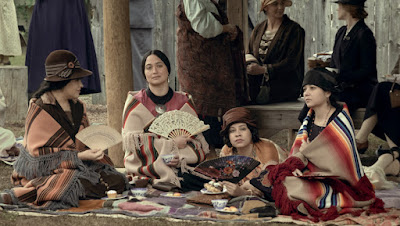Martin
Scorsese’s Killersof the Flower Moon
is a timely and masterful meditation on the smallness of strongmen
and their followers.
Scorsese
leaves viewers no doubt as to the sorrow and pity inflicted by white
ne’er-do-wells on people of the Osage Nation in his retelling of
this true-crime story. What makes it poignant and universal is his
ability to draw from his cast qualities that make their characters
personalities with points of view and feelings who are people we all
know and who would be recognized anywhere in the world. Business as
Scorsese portrays it here gets no more personal than this.
And
yes, the prospect of spending three-and-a-half intermission-less
hours of one’s life seated in a dark room with strangers is
daunting. But we found ourselves at times so drawn into the space of
Scorsese’s story that we looked around the theater to make sure that we
were not right there in the room with his characters. So the short
answer is, see this on a big screen while you can. Our discussion
includes no spoilers.
Scorsese
bookends his narrative with stylized contemporary U.S. media
productions of the Osage and the so-called Reign of Terror which was
the murder of Osage oil lease owners—and the first case of the U.S.
Bureau of Investigation which would become the FBI.
U.S.
serviceman Ernest Burkhart (Leonardo DiCaprio) returns home to a
booming Fairfax, Oklahoma, after serving as a cook in World War I. He is not
particularly interesting, intelligent, or ambitious. He walks among
Indians ostentatiously celebrating the enormous wealth oil has
brought them, fancy clothes, cars, and hats. We also see sepia-toned
stills and movie clips with old-time title cards. An orphan, Burkhart
visits his uncle William “call me ‘King’” Hale (Robert De
Niro) seeking work. King Bill Hale’s cattle business made him
prosperous. He is the resident Big White Man who has a long
association with the Osage and speaks their language. But he had no
oil under his cattle ranch.
Since
individual property owners ordinarily do not drill for and extract
oil, the game is leases: Owners lease property to oil companies to
receive “royalties” on their mineral rights. Much of Oklahoma’s
oil lay under Indian reservations. Due to legal and financial
settlements devolved from U.S. Government treaties with indigenous
peoples, federal authorities did not recognize non-Indian leases in
Oklahoma.
Thus the issue in this film set in the Osage Nation is the
“headright”, one of about 2200 shares of land allotted equally to
its tribal members. Mineral rights were held in common, each
headright getting an equal share of the oil lease royalty.
However,
non-Indians could acquire headrights though legal marriage to a
headright, unmarried or widowed, which is precisely what King
encourages Ernest to do with Mollie (Lily Gladstone), one of four
Osage headright sisters: Reta (Janae Collins), Anna (Cara Jade
Myers), and Minnie (Jillian Dion). (There is no mention of female
non-Indians marrying male Indian headrights.) Mollie, her sisters and
the other Osage have no doubt that these white layabouts are after
their money; but life is short, money is just money, and these guys
are not bad looking. Grounded in cultural pride and tradition, the
Osage are tragically blind to the disdain of rootless uncultured
bigots and the delusions of power money can give them.
The
story bookends with a closing summary on a World War II-era (Lucky
Strike green) live in-studio broadcast of the Osage murders as a
radio murder mystery; Scorsese reads King Bill Hale's obituary; and he closes with an aerial shot of a modern Osage community dance
that makes a flower mandala.
The film’s title comes from an Osage
folktale read aloud by Ernest from a book King gave him to help
understand them. The “flower-killing moon” is a time in late
spring when purple and white flowers which Scorsese shows us covering the
land are overshadowed and crowded out by taller plants, returning
those flowers to the earth to come back the next year. Scorsese
does his big scenes with crowds with his usual panache.
Color in the
costume of his Osage characters works along lines similar to Akira
Kurosawa in the latter’s stories set in Japan’s Edo period. In a
scene striking in its beauty and simplicity, a dying Osage woman is
approached in broad daylight by three ritual figures in plain
costumes of primary colors, perhaps her former husband and parents,
who lead her away.
And
Robbie Robertson’s soundtrack is excellent. It features North
American “roots” and popular music of the 1920s as well as
indigenous drumming and chants. Best known as guitarist and song
writer for The Band and work with Bob Dylan, Robertson, whose mother
was a Mohawk, has said that he was first inspired to be a musician
among family on the Six Nations of the Grand River reserve in
Ontario, Canada. Robertson died in August: Scorsese, who worked with
him for 55 years, dedicated this film to his memory.
Killers
of the Flower Moon
2023
U.S. (206 minutes) Appian Way/Apple Studios/Paramount Pictures.
Directed by Martin Scorsese; co-written by Scorsese and Eric Roth,
based on David Grann’s 2017 book Killers
of the Flower Moon: The Osage Murders and the Birth of the FBI;
music by Robbie Robertson; Rodrigo Prieto, director of photography;
editing by Thelma Schoonmaker; production design by Jack Fisk;
costume design by Jacqueline West; produced by Scorsese, Dan
Friedkin, Bradley Thomas, and Daniel Kupi.






